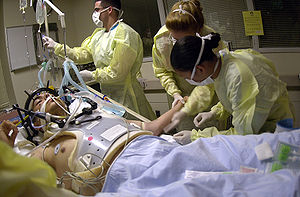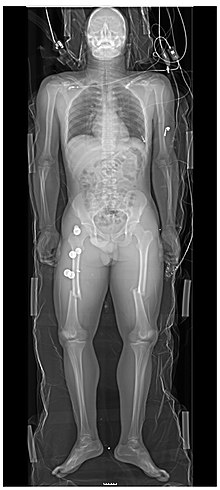重大创伤
| 重大创伤 | |
|---|---|
 | |
| 医护人员照顾担架床上一位头部遭受枪伤的患者,已给予气管插管,背景可见使用呼吸器。 | |
| 分类和外部资源 | |
| 医学专科 | 急诊医学、创伤外科 |
| ICD-10 | S00、S90、T14.0 |
重大
2002年,意外事故和故意伤害是全球第五和第七大死因,分别占所有死亡人数的6.23%和2.84%。基于研究目的,重大创伤定义为外伤严重度分数[2][3]大于15[4]。
分类
创伤通常按严重程度、伤害的位置、或综合两者来进行分类[5]。创伤也可以按人口统计学分类,例如年龄或性别[6]。也可以根据伤害对身体施力的类型进行分类,例如钝性创伤或穿透性创伤。出于研究目的,可以使用基于国际疾病与相关健康问题统计分类(ICD-9-CM)的巴雷尔氏诊断统计矩阵(Barel matrix)对创伤进行分类,用于将创伤分类国际标准化[7]。重大创伤有时按身体部位分类,其中40%是多重创伤,30%头部损伤,20%胸部创伤,10%腹部创伤,2%肢体创伤[6][8]。
有多种量表可量化评估损伤的严重程度,用于对病患进行分类或统计分析。简易外伤分数[9]和格拉斯哥昏迷指数常用于量化损伤程度以进行分类,并可让医疗系统在临床环境中监视或预测病患的病情趋势[10]。数据也可用于流行病学调查和研究[11]。
病因
任何作用于身体的物理性外力都可能造成损伤[13]。创伤致死的主要原因是钝性创伤、车祸、跌倒,其次是刺伤等穿透性创伤[14][15]。
作为统计用途,伤害分为故意伤害(例如自杀)或意外事故(例如车祸)。故意伤害是造成创伤的常见原因[16]。子弹或刀等异物进入人体组织可造成开放性伤口,属于穿透性创伤。在美国,大多数由穿透性创伤造成的死亡发生在都会区,其中80%是由枪支造成的[17]。爆炸伤是造成创伤的复合性病因,因为它通常既包括钝性创伤也包括穿透性创伤,还可能伴有灼伤。创伤也可能与特定活动有关,例如职业伤害或运动伤害[18]。
诊断

理学检查
第一阶段理学检查要确认任何危及生命的问题,可能在运送病患的过程中或到达医院时执行。第二阶段理学检查包括对腹部、骨盆、胸部区域的系统评估、完整检视身体表面以发现所有损伤、以及神经学检查。损伤的征象可能稍晚才会显现,或损伤可能在初步评估中遗漏,例如病患初进医院急诊室时[19]。通常理学检查是有系统地进行,首先检查是否存在任何即时生命威胁(初步调查),然后进行更深入的检查(二次调查)[20]。
影像检查

重大创伤病患通常会接受胸部和骨盆的X光检查[8],并根据损伤的机转和表现使用外伤重点式超声波评估(FAST)检查是否有内部出血。对于血压和心率相对稳定且血氧浓度较高的病患,计算机断层成像很有用[8][21]。全身计算机断层成像可以提高重大创伤病患的存活率[22][23]。这些扫描使用静脉注射的造影剂,而非口服的[24]。有专家担心在创伤不明的状况下,未先确认肾功能是否足够就给予静脉造影剂,也许会损害肾脏,但相关证据并未发现显著损害[21]。
在美国,急诊室有15%的创伤病患接受计算机断层成像或核磁共振检查[25]。低血压或心率加快且怀疑腹部出血时,建议跳过计算机断层成像而直接进行手术[26]。现代的64切计算机断层成像可以高度准确地排除钝性创伤是否造成重要的颈部损伤[27]。
处置


到院前
在送达最近能够医治创伤的医院前,利用稳定技巧可以提高病患在这段路程的存活机会。紧急医疗服务决定哪些病患需要在创伤中心接受治疗,并检查与处理呼吸道、呼吸、循环、评估失能、检查其他伤害,以提供病患初步的稳定[19]。
到院前以颈圈固定颈部并将病患放在长背板上做脊椎固定非常重要,但是由于缺乏支持的证据,这种做法不受欢迎;相对的,如果满足更多特定条件,比如年龄或神经功能缺损,则建议必须使用这些辅助工具[28][29]。移动病患前可以利用其他医疗运输设备来帮忙,例如长躯干固定器[30][31]。重要的是在伤口上直接加压以迅速控制严重的出血,如果症状持续,可以考虑使用止血剂或止血带[32]。其他状况包括急性呼吸道阻塞、恶化的颈部血肿、意识不清需要气管插管等,然而目前尚不确定这些情况是在到达医院前或在医院中进行何者为佳[33]。
快速运送重伤病患可改善创伤的预后[8][19]。与地面运输相比,直升机运输可降低成年创伤病患的死亡率[34]。在到达医院之前,与基本救命术相比,提供进阶生命救命术并不能大幅改善重大创伤的结果[35][36]。到院前是否应给予静脉输液治疗的相关证据尚无定论,但有些证据表示这可能有害[37]。与没有创伤中心的医院相比,有创伤中心者治疗结果较佳[8];创伤病患能直接送到创伤治疗中心者,治疗结果可能较佳[38]。
到院后
创伤病患的治疗通常需要许多医疗专业人员的协助,包括医生、护士、呼吸治疗师、社会工作者。通常先进行初步调查,评估病患的呼吸道、呼吸、循环、神经系统的状况[39]。这些步骤可能同时进行,也可能取决于其紧迫性,例如张力性气胸或大动脉出血。初步调查通常包括对颈椎的评估,尽管要等到影像检查或病情改善后才能确定排除颈椎的问题。直接威胁生命的问题获得控制后,病患可能被送进手术室立即以外科手术处理伤势,或者进行二次调查,更详细地从头到脚全面评估[40]。
气管插管的适应症包括呼吸道阻塞、无法保护呼吸道、呼吸衰竭[41],这些适应症的例子包括颈部穿透性创伤、正在恶化的颈部血肿、失去知觉等。创伤的复苏包括控制住活动性出血,检查生命征象、执行心电图、建立血管通路。应进行其他测试以取得当前血液化学数据,例如动脉血气体分析或血栓弹力图[42][43]。一般认为心肺复苏术对因创伤而心搏停止的病患效果不佳,但仍建议给予[44],处理潜在病因可能会有帮助,比如气胸或心包填塞[44]。
某些创伤让训练有素的医疗人员来维持呼吸道、呼吸、循环功能可能是有益的,例如颌面创伤[45]。
药物
传明酸可减少因创伤而持续流血者的死亡率,对轻度到中度脑外伤及计算机断层成像显示有颅内出血的病患也有帮助[46][47][48],但是似乎只有在创伤后的前三个小时内使用才有益[49]。对于严重的出血,例如凝血病,可能适合给予重组因子VIIa(一种有助于凝血的蛋白质)[8][50],但似乎未能降低死亡率[51],不建议用于没有重组因子VII缺乏症病史的病患,除非是人体试验[52]。
有些药物可以与其他治疗处置合并给予,以稳定遭受严重损害的病患[6]。虽然强心剂(如去甲基肾上腺素)有时会用于创伤导致的出血性休克,但仍缺乏支持的证据[53],因此截至2012年仍未列入建议[54]。在某些情况下,适度的低血压是被允许的[55]。
外科手术
是否进行手术取决于损伤的程度和解剖位置。必须先能控制住出血,然后才能有妥善的修复[56]。损伤控制手术[57]用于处理严重的创伤,如果未能妥善处理,可能因代谢性酸中毒、失温症、低血压等一系列过程导致死亡[8],手术的主要原则是采用最少的步骤来挽救生命和肢体,将比较次要的步骤留待病患状况更稳定后再执行[8]。所有创伤病患中约15%有腹部损伤,其中约25%需要进行探查性手术。可预防的创伤致死大多数起因于未能发现腹腔内出血[58]。
参考资料
- ^ Glossary. National Highway Traffic Safety Administration. [26 March 2014]. (原始内容存档于2016-11-27).
- ^ 外傷嚴重度分數. 中国医药大学医学影像学习园地. [2020-09-12]. (原始内容存档于2019-09-09).
- ^ 外傷嚴重度分數(ISS) (PDF). 卫生福利部中央健康保险署. [2020-09-23].
- ^ Palmer, C. Major trauma and the injury severity score—where should we set the bar?. Annual Proceedings of the Association for the Advancement of Automotive Medicine. 2007, 51: 13–29. PMC 3217501
 . PMID 18184482.
. PMID 18184482.
- ^ Moore 2013, p. 77
- ^ 6.0 6.1 6.2 Marx, J. Rosen's emergency medicine: concepts and clinical practice 7th. Philadelphia: Mosby/Elsevier. 2010: 243–842. ISBN 978-0323054720.
- ^ The Barell Injury Diagnosis Matrix, Classification by Body Region and Nature of the Injury. Center for Disease Control. [19 June 2013]. (原始内容存档于2019-10-15).
- ^ 8.0 8.1 8.2 8.3 8.4 8.5 8.6 8.7 Bonatti, H; Calland, JF. Trauma. Emergency Medicine Clinics of North America. 2008, 26 (3): 625–48. PMID 18655938. doi:10.1016/j.emc.2008.05.001.
- ^ 外傷嚴重度分數. 中国医药大学医学影像学习园地. [2020-09-11]. (原始内容存档于2019-09-09).
- ^ Moore 2013, pp. 77–98
- ^ Discussion document on injury severity measurement in administrative datasets (PDF). Centers for Disease Control and Prevention: 1–3. September 2004 [2013-05-24]. (原始内容存档 (PDF)于2017-08-29).
- ^ Ahn, H; Singh, J; Nathens, A; MacDonald, RD; Travers, A; Tallon, J; Fehlings, MG; Yee, A. Pre-hospital care management of a potential spinal cord injured patient: a systematic review of the literature and evidence-based guidelines. Journal of Neurotrauma. Aug 2011, 28 (8): 1341–61. PMC 3143405
 . PMID 20175667. doi:10.1089/neu.2009.1168.
. PMID 20175667. doi:10.1089/neu.2009.1168.
- ^ Moore 2013, p. 2
- ^ DiPrima Jr., PA. EMT-Basic. McGraw-Hill. 2008-03-21: 227–33. ISBN 978-0071496797.
- ^ Dickenson ET, Limmer D, O'Keefe MF. Emergency Care. 2009. ISBN 978-0135005231.
- ^ Jeff Garner; Greaves, Ian; Ryan, James R.; Porter, Keith R. Trauma care manual. London: Hodder Arnold. 2009. ISBN 978-0340928264.
- ^ Medzon R, Mitchell EJ. Introduction to Emergency Medicine. Philadelphia: Lippincott Williams & Willkins. 2005: 393–431. ISBN 978-0781732000.
- ^ Kannus, P.; Parkkari, J.; Jarvinen, T.; Jarvinen, A.; Jarvinen, M. Basic science and clinical studies coincide: active treatment approach is needed after a sports injury. Scandinavian Journal of Medicine & Science in Sports. June 2003, 13 (3): 150–54. PMID 12753486. doi:10.1034/j.1600-0838.2003.02225.x.
- ^ 19.0 19.1 19.2 Committee on Trauma, American College of Surgeons. ATLS: Advanced Trauma Life Support Program for Doctors 8th. Chicago: American College of Surgeons. 2008. ISBN 978-1880696316.
- ^ Moore 2013, p
- ^ 21.0 21.1 McGillicuddy EA, Schuster KM, Kaplan LJ, et al. Contrast-induced nephropathy in elderly trauma patients. J Trauma. 2010, 68 (2): 294–97. PMID 20154540. doi:10.1097/TA.0b013e3181cf7e40.
- ^ Huber-Wagner S, Lefering R, Qvick LM, et al. Effect of whole-body CT during trauma resuscitation on survival: a retrospective, multicentre study. Lancet. 2009, 373 (9673): 1455–61. PMID 19321199. doi:10.1016/S0140-6736(09)60232-4.
- ^ Jiang, L; Ma, Y; Jiang, S; Ye, L; Zheng, Z; Xu, Y; Zhang, M. Comparison of whole-body computed tomography vs selective radiological imaging on outcomes in major trauma patients: a meta-analysis. Scandinavian Journal of Trauma, Resuscitation and Emergency Medicine. September 2, 2014, 22 (1): 54. PMC 4347587
 . PMID 25178942. doi:10.1186/s13049-014-0054-2.
. PMID 25178942. doi:10.1186/s13049-014-0054-2.
- ^ Allen TL, Mueller MT, Bonk RT, Harker CP, Duffy OH, Stevens MH. Computed tomographic scanning without oral contrast solution for blunt bowel and mesenteric injuries in abdominal trauma. J Trauma. 2004, 56 (2): 314–22. PMID 14960973. doi:10.1097/01.TA.0000058118.86614.51.
- ^ Korley FK, Pham JC, Kirsch TD. Use of advanced radiology during visits to US emergency departments for injury-related conditions,1998–2007. JAMA. 2010, 304 (13): 1465–71. PMID 20924012. doi:10.1001/jama.2010.1408.
- ^ Neal MD, Peitzman AB, Forsythe RM, et al. Over reliance on computed tomography imaging in patients with severe abdominal injury: is the delay worth the risk?. J Trauma. February 2011, 70 (2): 278–84. PMID 21307722. doi:10.1097/TA.0b013e31820930f9.
- ^ Kanji, HD; Neitzel, A; Sekhon, M; McCallum, J; Griesdale, DE. Sixty-four-slice computed tomographic scanner to clear traumatic cervical spine injury: systematic review of the literature.. Journal of Critical Care. Apr 2014, 29 (2): 314.e9–13. PMID 24393410. doi:10.1016/j.jcrc.2013.10.022.
- ^ Sundstrøm, Terje; Asbjørnsen, Helge; Habiba, Samer; Sunde, Geir Arne; Wester, Knut. Prehospital Use of Cervical Collars in Trauma Patients: A Critical Review. Journal of Neurotrauma. 2013-08-20, 31 (6): 531–40. ISSN 0897-7151. PMC 3949434
 . PMID 23962031. doi:10.1089/neu.2013.3094.
. PMID 23962031. doi:10.1089/neu.2013.3094.
- ^ Singletary, Eunice M.; Charlton, Nathan P.; Epstein, Jonathan L.; Ferguson, Jeffrey D.; Jensen, Jan L.; MacPherson, Andrew I.; Pellegrino, Jeffrey L.; Smith, William “Will” R.; Swain, Janel M. Part 15: First Aid. Circulation. 2015-11-03, 132 (18 suppl 2): S574–89. ISSN 0009-7322. PMID 26473003. doi:10.1161/CIR.0000000000000269 (英语).
- ^ 裝備櫥窗. 内政部消防署消防电子报数据库. [2020-09-23]. (原始内容存档于2021-04-16).
- ^ Karbi, OA; Caspari, DA; Tator, CH. Extrication, immobilization and radiologic investigation of patients with cervical spine injuries. Canadian Medical Association Journal. 1988, 139 (7): 617–21. PMC 1268249
 . PMID 3046734.
. PMID 3046734.
- ^ Moore 2013, pp. 154–66
- ^ Bulger, EM; Maier, RV. Prehospital care of the injured: what's new.. The Surgical Clinics of North America. Feb 2007, 87 (1): 37–53, vi. PMID 17127122. doi:10.1016/j.suc.2006.09.009.
- ^ Sullivent, EE; Faul, M; Wald, MM. Reduced mortality in injured adults transported by helicopter emergency medical services. Prehospital Emergency Care. Jul–Sep 2011, 15 (3): 295–302 [2020-09-22]. PMID 21524205. doi:10.3109/10903127.2011.569849. (原始内容存档于2020-10-09).
- ^ Stiell IG, Nesbitt LP, Pickett W, et al. The OPALS Major Trauma Study: impact of advanced life-support on survival and morbidity. CMAJ. 2008, 178 (9): 1141–52. PMC 2292763
 . PMID 18427089. doi:10.1503/cmaj.071154.
. PMID 18427089. doi:10.1503/cmaj.071154.
- ^ Liberman M, Roudsari BS. Prehospital trauma care: what do we really know?. Curr Opin Crit Care. 2007, 13 (6): 691–96. PMID 17975392. doi:10.1097/MCC.0b013e3282f1e77e.
- ^ Dretzke J, Sandercock J, Bayliss S, Burls A. Clinical effectiveness and cost-effectiveness of prehospital intravenous fluids in trauma patients. Health Technol Assess. 2004, 8 (23): iii, 1–103. PMID 15193210. doi:10.3310/hta8230.
- ^ Nirula R, Maier R, Moore E, Sperry J, Gentilello L. Scoop and run to the trauma center or stay and play at the local hospital: hospital transfer's effect on mortality. J Trauma. 2010, 69 (3): 595–99; discussion 599–601. PMID 20838131. doi:10.1097/TA.0b013e3181ee6e32.
- ^ Moore 2013, p. 160
- ^ Moore 2013, p. 163
- ^ Nemeth, J; Maghraby, N; Kazim, S. Emergency airway management: the difficult airway.. Emergency Medicine Clinics of North America. May 2012, 30 (2): 401–20, ix. PMID 22487112. doi:10.1016/j.emc.2011.12.005.
- ^ 血栓彈力圖在病人輸血管理的臨床應用. 社团法人台湾医事检验学会. [2020-09-24].
- ^ Moore 2013, p. 161
- ^ 44.0 44.1 Vanden Hoek TL, Morrison LJ, Shuster M, Donnino M, Sinz E, Lavonas EJ, Jeejeebhoy FM, Gabrielli A. Part 12: cardiac arrest in special situations: 2010 American Heart Association Guidelines for Cardiopulmonary Resuscitation and Emergency Cardiovascular Care. Circulation. 2010-11-02, 122 (18 Suppl 3): S829–61. PMID 20956228. doi:10.1161/CIRCULATIONAHA.110.971069.
- ^ Krausz AA, El-Naaj IA, Barak M. Maxillofacial trauma patient: coping with the difficult airway. World Journal of Emergency Surgery. 2009, 4: 21. PMC 2693512
 . PMID 19473497. doi:10.1186/1749-7922-4-21.
. PMID 19473497. doi:10.1186/1749-7922-4-21.
- ^ Shakur H, Roberts I, Bautista R, Caballero J, Coats T, Dewan Y, El-Sayed H, Gogichaishvili T. Effects of tranexamic acid on death, vascular occlusive events, and blood transfusion in trauma patients with significant haemorrhage (CRASH-2): a randomised, placebo-controlled trial. The Lancet. 2010, 376 (9734): 23–32. PMID 20554319. doi:10.1016/S0140-6736(10)60835-5.
- ^ Cap AP, Baer DG, Orman JA, Aden J, Ryan K, Blackbourne LH. Tranexamic acid for trauma patients: a critical review of the literature. The Journal of Trauma. July 2011, 71 (1 Suppl): S9–14. PMID 21795884. doi:10.1097/TA.0b013e31822114af.
- ^ CRASH-3 trial collaborators. Effects of tranexamic acid on death, disability, vascular occlusive events and other morbidities in patients with acute traumatic brain injury (CRASH-3): a randomised, placebo-controlled trial. The Lancet. 2019-11-09, 394 (10210): 1713–1723. ISSN 0140-6736. PMC 6853170
 . PMID 31623894. doi:10.1016/S0140-6736(19)32233-0 (英语).
. PMID 31623894. doi:10.1016/S0140-6736(19)32233-0 (英语).
- ^ Napolitano, LM; Cohen, MJ; Cotton, BA; Schreiber, MA; Moore, EE. Tranexamic acid in trauma: how should we use it?. The Journal of Trauma and Acute Care Surgery. June 2013, 74 (6): 1575–86. PMID 23694890. doi:10.1097/ta.0b013e318292cc54.
- ^ Roppolo LP, Wigginton JG, Pepe PE. Intravenous fluid resuscitation for the trauma patient. Curr Opin Crit Care. 2010, 16 (4): 283–88. PMID 20601865. doi:10.1097/MCC.0b013e32833bf774.
- ^ Hauser CJ, Boffard K, Dutton R, et al. Results of the CONTROL trial: efficacy and safety of recombinant activated Factor VII in the management of refractory traumatic hemorrhage. J Trauma. September 2010, 69 (3): 489–500. PMID 20838118. doi:10.1097/TA.0b013e3181edf36e.
- ^ Simpson, E; Lin, Y; Stanworth, S; Birchall, J; Doree, C; Hyde, C. Recombinant factor VIIa for the prevention and treatment of bleeding in patients without haemophilia. Cochrane Database of Systematic Reviews. Mar 14, 2012, 3 (3): CD005011. PMID 22419303. doi:10.1002/14651858.CD005011.pub4. hdl:10871/13808.
- ^ Senz, A; Nunnink, L. Review article: inotrope and vasopressor use in the emergency department. Emergency Medicine Australasia. Oct 2009, 21 (5): 342–51. PMID 19694785. doi:10.1111/j.1742-6723.2009.01210.x.
- ^ Kobayashi, L; Costantini, TW; Coimbra, R. Hypovolemic shock resuscitation. The Surgical Clinics of North America. Dec 2012, 92 (6): 1403–23. PMID 23153876. doi:10.1016/j.suc.2012.08.006.
- ^ Vasopressor and Inotrope Usage in Shock (PDF). Department of Surgical Education, Orlando Regional Medical Center. Apr 19, 2011 [4 May 2014]. (原始内容存档 (PDF)于2021-01-27).
- ^ Andrew B., MD Peitzman; Andrew B. Peitzman; Michael, MD Sabom; Donald M., MD Yearly; Timothy C., MD Fabian. The trauma manual. Hagerstwon, MD: Lippincott Williams & Wilkins. 2002. ISBN 978-0781726412.
- ^ 嚴重外傷病人的初始照護. 台湾急诊医学会. [2020-09-25].
- ^ Fitzgerald, J.E.F.; Larvin, Mike. Chapter 15: Management of Abdominal Trauma. Baker, Qassim; Aldoori, Munther (编). Clinical Surgery: A Practical Guide. CRC Press. 2009: 192–204. ISBN 978-1444109627.
参考书目
- Jeff Garner; Greaves, Ian; Ryan, James R.; Porter, Keith R. Trauma Care Manual. London, England: Hodder Arnold. 2009. ISBN 978-0340928264.
- Feliciano, David V.; Mattox, Kenneth L.; Moore, Ernest J. Trauma, Seventh Edition (Trauma (Moore)). McGraw-Hill Professional. 2012. ISBN 978-0071663519.
- Andrew B., Peitzman; Michael, MD Sabom; Donald M., MD Yearly; Timothy C., MD Fabian. The trauma manual. Hagerstwon, MD: Lippincott Williams & Wilkins. 2002. ISBN 978-0781726412.
延伸阅读
- Editorial Board, Army Medical Department Center & School (编). Emergency War Surgery 3rd. Washington, DC: Borden Institute. 2004 [2010-10-31]. (原始内容存档于2011-06-23).
- Zajtchuk, R; Bellamy, RF; Grande, CM (编). Textbook of Military Medicine, Part IV: Surgical Combat Casualty Care. 1: Anesthesia and Perioperative Care of the Combat Casualty. Washington, DC: Borden Institute. 1995 [2010-10-31]. (原始内容存档于2011-06-22).
参见
- 战术战斗伤患救护(TCCC/TC3)
外部链接
| |||||||
- International Trauma Conferences (页面存档备份,存于互联网档案馆) (registered trauma charity providing trauma education for medical professionals worldwide)
- Trauma.org (trauma resources for medical professionals)
- Emergency Medicine Research and Perspectives (emergency medicine procedure videos)
- American Trauma Society (页面存档备份,存于互联网档案馆)
- Scandinavian Journal of Trauma, Resuscitation and Emergency Medicine (页面存档备份,存于互联网档案馆)
| |||||||||||||||||||||||||||||||||||||
| ||||||||||||
Text is available under the CC BY-SA 4.0 license; additional terms may apply.
Images, videos and audio are available under their respective licenses.
